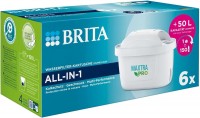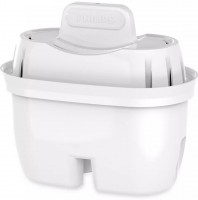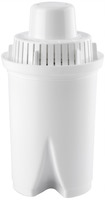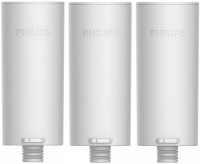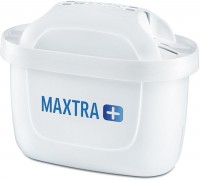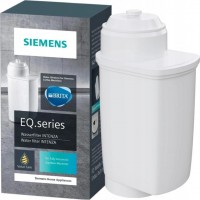Water Filter Cartridges Aquaphor
All models Advanced filters → |
You might be interested in
Water Filter Cartridges: specifications, types
Cartridge type
Type of cartridge and scope of its application.
– Flow-through. Cartridges designed for use in flow-through filtration systems - mainline or installed under the sink. They may differ in the degree of contaminant removal and types of filtration (see the corresponding paragraphs), however, all such products have a high throughput, otherwise the filter would simply interfere with the free flow of water in the water supply. Flow systems are quite difficult to install - they require special stationary installation without the ability to be transported from place to place.
— Reverse osmosis kits. Reverse osmosis filter sets are the most effective water treatment systems. Such systems have at least 5 stages of water purification; accordingly, purchasing filters in sets is cheaper than purchasing filter elements separately. Such sets differ from conventional kits in the expanded number of filters - in particular, reverse osmosis systems contain a special membrane (see below), mineralizers, pre- and post-filters.
— Filter jug. Cartridges designed for installation in filter jugs. Such filters are containers divided into two parts: water is poured into the upper one, which, under its own weight, flows through the cartridge into the lower container. Jugs have low productivity and are generally inferior in filtration efficiency to flow-through and, espe...cially, osmotic systems (see the relevant paragraphs); on the other hand, they are extremely simple, inexpensive and easy to use, and are also quite compact and portable - the jug can be taken with you if necessary. And the degree of purification may be quite sufficient if the water is not very polluted.
– On faucet. Cartridges for filters that fit onto a water faucet. Such systems are a cross between flow-through systems and jug filters. They differ from the former in ease of installation, as well as lower productivity and degree of purification; on the other hand, faucet filters work faster and more efficiently than the same jugs. At the same time, such a filter is not designed for constant use; it has to be constantly connected/disconnected, which is not very convenient and leads to wear on the faucet mount.
— Tourist. Cartridges for travel filters. As the name suggests, such filters are designed for trips, hikes and other situations associated with being “away from civilization.” They can have different designs, but a prerequisite is compactness and the ability to work with water without pressure.
– For shower. Cartridges for filters installed on the shower head or in front of the hose. In the overwhelming majority, such systems are designed to improve the quality of water - eliminate odors, soften water for a gentle effect on the skin and hair, and reduce dryness of the skin after taking “bath procedures”.
— Filter kits. Sets of filter elements for water purification systems. Sets of cartridges are supposed to be installed in strict sequence according to the manufacturer’s instructions, since the sets usually include elements with different filtering purposes: for mechanical cleaning, carbon cleaning, water softening, reducing iron levels, etc. The kits are available in various variations, so you can select the appropriate set of filter elements depending on the specific water parameters. Purchasing them en masse allows you to avoid replacing filters in water treatment systems separately.
— Membrane. Specialized membranes for reverse osmosis filtration systems carry out water purification at the molecular level - the membrane allows water molecules to pass through and retains larger contaminant molecules. The reverse is the osmotic process, in which water moves through a membrane from a solution with a higher concentration of impurities to a solution with a lower concentration. This allows contaminants to remain on one side of the membrane, allowing only clean water to pass through, ensuring the highest degree of purification. Due to regular washing, membranes have a long service life - many times longer than other filter elements, and their main disadvantage is their low productivity. It is caused not only by the slow operation of the membrane, but also by the filtration of only part of the water - about 40%, the rest of the water is drained back into the sewer.
– Ultraviolet lamp. Cartridges with a built-in UV lamp purify water from pathogenic bacteria, fungi and other microorganisms through exposure to ultraviolet radiation. It is destructive to microorganisms, but does not affect the chemical properties of water and does not deteriorate its quality.
— For coffee machines. Replaceable cartridges designed for water purification in coffee machines - eliminating mechanical impurities, preventing scale formation, improving taste, etc. (in practice, everything depends on the implementation of the filtration system). Note that such cartridges are usually produced for a specific model or line of coffee makers - it is important to clarify their compatibility.
– Flow-through. Cartridges designed for use in flow-through filtration systems - mainline or installed under the sink. They may differ in the degree of contaminant removal and types of filtration (see the corresponding paragraphs), however, all such products have a high throughput, otherwise the filter would simply interfere with the free flow of water in the water supply. Flow systems are quite difficult to install - they require special stationary installation without the ability to be transported from place to place.
— Reverse osmosis kits. Reverse osmosis filter sets are the most effective water treatment systems. Such systems have at least 5 stages of water purification; accordingly, purchasing filters in sets is cheaper than purchasing filter elements separately. Such sets differ from conventional kits in the expanded number of filters - in particular, reverse osmosis systems contain a special membrane (see below), mineralizers, pre- and post-filters.
— Filter jug. Cartridges designed for installation in filter jugs. Such filters are containers divided into two parts: water is poured into the upper one, which, under its own weight, flows through the cartridge into the lower container. Jugs have low productivity and are generally inferior in filtration efficiency to flow-through and, espe...cially, osmotic systems (see the relevant paragraphs); on the other hand, they are extremely simple, inexpensive and easy to use, and are also quite compact and portable - the jug can be taken with you if necessary. And the degree of purification may be quite sufficient if the water is not very polluted.
– On faucet. Cartridges for filters that fit onto a water faucet. Such systems are a cross between flow-through systems and jug filters. They differ from the former in ease of installation, as well as lower productivity and degree of purification; on the other hand, faucet filters work faster and more efficiently than the same jugs. At the same time, such a filter is not designed for constant use; it has to be constantly connected/disconnected, which is not very convenient and leads to wear on the faucet mount.
— Tourist. Cartridges for travel filters. As the name suggests, such filters are designed for trips, hikes and other situations associated with being “away from civilization.” They can have different designs, but a prerequisite is compactness and the ability to work with water without pressure.
– For shower. Cartridges for filters installed on the shower head or in front of the hose. In the overwhelming majority, such systems are designed to improve the quality of water - eliminate odors, soften water for a gentle effect on the skin and hair, and reduce dryness of the skin after taking “bath procedures”.
— Filter kits. Sets of filter elements for water purification systems. Sets of cartridges are supposed to be installed in strict sequence according to the manufacturer’s instructions, since the sets usually include elements with different filtering purposes: for mechanical cleaning, carbon cleaning, water softening, reducing iron levels, etc. The kits are available in various variations, so you can select the appropriate set of filter elements depending on the specific water parameters. Purchasing them en masse allows you to avoid replacing filters in water treatment systems separately.
— Membrane. Specialized membranes for reverse osmosis filtration systems carry out water purification at the molecular level - the membrane allows water molecules to pass through and retains larger contaminant molecules. The reverse is the osmotic process, in which water moves through a membrane from a solution with a higher concentration of impurities to a solution with a lower concentration. This allows contaminants to remain on one side of the membrane, allowing only clean water to pass through, ensuring the highest degree of purification. Due to regular washing, membranes have a long service life - many times longer than other filter elements, and their main disadvantage is their low productivity. It is caused not only by the slow operation of the membrane, but also by the filtration of only part of the water - about 40%, the rest of the water is drained back into the sewer.
– Ultraviolet lamp. Cartridges with a built-in UV lamp purify water from pathogenic bacteria, fungi and other microorganisms through exposure to ultraviolet radiation. It is destructive to microorganisms, but does not affect the chemical properties of water and does not deteriorate its quality.
— For coffee machines. Replaceable cartridges designed for water purification in coffee machines - eliminating mechanical impurities, preventing scale formation, improving taste, etc. (in practice, everything depends on the implementation of the filtration system). Note that such cartridges are usually produced for a specific model or line of coffee makers - it is important to clarify their compatibility.
Items in set
The number of individual cartridges in the delivery set.
There can be more than one cartridge in a set; the meaning of such a configuration directly depends on the application (see the relevant paragraph). So, each cartridge is usually responsible for its own filtration stage in flow systems, they are installed simultaneously (in series) and the number of cartridges more or less corresponds to the number of purification stages (see the relevant paragraph). And in the case of filter jugs, the sets consist of several cartridges of the same type and are intended for those who want to buy several replacement elements in reserve (or equip several jugs with the same cartridges at once). However, buying a set can be more convenient anyway, if not profitable, than buying filter elements separately.
Now on the market there are sets with the following number of cartridges: 1 cartridge, 2 cartridges, 3 cartridges and 4 cartridges and more.
There can be more than one cartridge in a set; the meaning of such a configuration directly depends on the application (see the relevant paragraph). So, each cartridge is usually responsible for its own filtration stage in flow systems, they are installed simultaneously (in series) and the number of cartridges more or less corresponds to the number of purification stages (see the relevant paragraph). And in the case of filter jugs, the sets consist of several cartridges of the same type and are intended for those who want to buy several replacement elements in reserve (or equip several jugs with the same cartridges at once). However, buying a set can be more convenient anyway, if not profitable, than buying filter elements separately.
Now on the market there are sets with the following number of cartridges: 1 cartridge, 2 cartridges, 3 cartridges and 4 cartridges and more.
Size
Cartridges for flow and reverse osmosis systems can belong to one of two classes: SL (Slim Line) for small filters where compact size and ease of cartridge replacement are important, and BB (Big Blue) for large systems where high flow Rate and processing ability are required significant volumes of water. At the same time, the standard size is usually indicated in height and diameter. These figures are expressed in inches.
First of all, the size allows you to assess the compatibility of the cartridge with a specific filter. Here we note that filter housings are available in standard sizes, and many cartridges are quite compatible with “non-native” filters due to the same size. In addition, the larger the filter element (all other things being equal), the larger its effective area and the higher the throughput.
Cartridges are often marked 5SL (5"x2.5"), 10SL (10"x2.5"), 20SL (20"x2.5"), 10BB (10"x4.5"), 20BB (20"x4. 5").
The size of membranes for reverse osmosis systems is also expressed in inches. The most widely used options are 12”x1.8”, 12”x2”, 12”x3”, 13”x3”.
Standard sizes also have linear cartridges...in the form of modules made of white or transparent plastic. However, they may differ in the types of connections to the pipes (¼” internal thread, quick-release adapter to ¼” tube, ¼” adapter rod). And cartridges for some water treatment systems are produced in proprietary sizes and are suitable only for specific filters.
First of all, the size allows you to assess the compatibility of the cartridge with a specific filter. Here we note that filter housings are available in standard sizes, and many cartridges are quite compatible with “non-native” filters due to the same size. In addition, the larger the filter element (all other things being equal), the larger its effective area and the higher the throughput.
Cartridges are often marked 5SL (5"x2.5"), 10SL (10"x2.5"), 20SL (20"x2.5"), 10BB (10"x4.5"), 20BB (20"x4. 5").
The size of membranes for reverse osmosis systems is also expressed in inches. The most widely used options are 12”x1.8”, 12”x2”, 12”x3”, 13”x3”.
Standard sizes also have linear cartridges...in the form of modules made of white or transparent plastic. However, they may differ in the types of connections to the pipes (¼” internal thread, quick-release adapter to ¼” tube, ¼” adapter rod). And cartridges for some water treatment systems are produced in proprietary sizes and are suitable only for specific filters.
Water temperature
The purpose is determined by the temperature of the water for which the filter is intended.
Most modern filters are designed for cold water (with temperatures up to +38...+40 °C), but models are also available for hot water, as well as universal solutions suitable for both cases. It is impossible to deviate from the recommendations for the purpose: an abnormal water temperature, at best, will reduce the efficiency of the filter, at worst, it will lead to its complete failure; and when passing hot water through a "cold" filter, even the release of harmful substances into the water is possible.
Most modern filters are designed for cold water (with temperatures up to +38...+40 °C), but models are also available for hot water, as well as universal solutions suitable for both cases. It is impossible to deviate from the recommendations for the purpose: an abnormal water temperature, at best, will reduce the efficiency of the filter, at worst, it will lead to its complete failure; and when passing hot water through a "cold" filter, even the release of harmful substances into the water is possible.
Pollution clipping
The smallest particle size that the cartridge is capable of retaining; smaller contaminants will be able to penetrate through it. Accordingly, the smaller the number in this point, the finer the filtering provided by the cartridge. On the other hand, increasing the filtration thoroughness inevitably reduces the performance, other things being equal. So the choice of cartridge is often based on a compromise between thoroughness of cleaning and throughput.
Also note that the choice depends on the purification stage at which the cartridge is planned to be installed. So, at the initial stage, coarse cleaning is used, with clipping impurities at the level of 25 microns or more. Filter elements with an index from 25 to 0.3 microns are classified as fine filters, and lower values are typical for ultra-fine elements, in particular, for osmotic membranes (see "Application").
Also note that the choice depends on the purification stage at which the cartridge is planned to be installed. So, at the initial stage, coarse cleaning is used, with clipping impurities at the level of 25 microns or more. Filter elements with an index from 25 to 0.3 microns are classified as fine filters, and lower values are typical for ultra-fine elements, in particular, for osmotic membranes (see "Application").
Filtration speed
The filtration rate provided by the cartridge, in other words, its maximum performance (throughput).
This indicator is directly related to the regular use of the cartridge (see above). It is also worth considering here that usually the finer the cleaning, the lower the performance of the filter element. Therefore, for example, flow pre-filter systems at the entrance to an apartment can be performant enough not to slow down the flow, but getting drinking water is inevitably associated with a slowdown in the process. This is especially true for reverse osmosis systems. Filter jugs also do not differ in performance, because they work without pressure. In addition, we note that when installing several filters in series (in a flow system), the final filtration speed will be limited by the speed of the slowest filter.
In general, when choosing a cartridge for a jug, a filter for a tap or a travel filter, you can not pay much attention to this parameter — performance is usually guaranteed to be enough to work for its intended purpose. Detailed recommendations for other types of filters can be found in special sources.
This indicator is directly related to the regular use of the cartridge (see above). It is also worth considering here that usually the finer the cleaning, the lower the performance of the filter element. Therefore, for example, flow pre-filter systems at the entrance to an apartment can be performant enough not to slow down the flow, but getting drinking water is inevitably associated with a slowdown in the process. This is especially true for reverse osmosis systems. Filter jugs also do not differ in performance, because they work without pressure. In addition, we note that when installing several filters in series (in a flow system), the final filtration speed will be limited by the speed of the slowest filter.
In general, when choosing a cartridge for a jug, a filter for a tap or a travel filter, you can not pay much attention to this parameter — performance is usually guaranteed to be enough to work for its intended purpose. Detailed recommendations for other types of filters can be found in special sources.
Resource
The resource of a cartridge is the amount of water that it can effectively pass through itself and clean without loss of working qualities. For reusable models (see below), the resource between cleanings/regenerations is usually indicated.
This parameter allows you to estimate how long the cartridge will last and how often it will need to be changed or cleaned. There are formulas that allow you to calculate the approximate water consumption depending on the number of people in the family and other factors; these formulas can be found in special sources. However, manufacturers themselves often make approximate calculations and indicate the frequency of replacement in the documents for a filter or cartridge: for example, “when used in a family of 3 people, change every month”. In fact, it is more convenient to use these recommendations.
This parameter allows you to estimate how long the cartridge will last and how often it will need to be changed or cleaned. There are formulas that allow you to calculate the approximate water consumption depending on the number of people in the family and other factors; these formulas can be found in special sources. However, manufacturers themselves often make approximate calculations and indicate the frequency of replacement in the documents for a filter or cartridge: for example, “when used in a family of 3 people, change every month”. In fact, it is more convenient to use these recommendations.
Resource
Approximate time in months after which a cartridge for water filtration systems will expire. As a rule, this parameter specifies the average intensity of use of the filter element - it allows you to roughly estimate how often you will need to change or clean the filter. After the specified period, the cartridge is not recommended to be used, as this may lead to a decrease in the quality of water purification.
Filtration and purification
Types of filtration provided by the cartridge. This parameter takes into account both the types of pollution that the product is able to cope with, and some features of its operation.
— Mechanical(impurities, sand). Purification from mechanical impurities — insoluble particles larger than a certain size (see "Pollution clipping"). The simplest cleaning method that can be achieved with relatively simple and inexpensive filter elements.
— Carbon(active chlorine, smell, taste). Purification through the use of activated carbon or other similar sorbent. Such a sorbent absorbs foreign substances dissolved in water, providing cleaning at the chemical level.
— Colloidal iron (rust). Purification of colloidal iron — particles suspended in water, which consist of insoluble iron compounds and give the water a characteristic "rusty" shade with a corresponding taste and smell. Some of this iron can be removed from the water by mechanical filtration, but additional chemical cleaning methods can be provided to increase efficiency. Therefore, this type of filtering is rendered separately.
— Hardness salts (limescale)). Removal of calcium and magnesium salts, which make water hard and lead to the formation of scale on heating elements (in particular, heating elements of washing...machines and dishwashers). Also note that excessive water hardness reduces the effectiveness of detergents. To remove hardness salts, different methods can be used, depending on the composition of the cartridge (see the relevant paragraph). So, ion-exchange resins take calcium and magnesium ions from water, replacing them with sodium ions; polyphosphate crystals form soluble compounds with hardness salts that do not limescale; and osmotic membranes (see "Application") filter out salts at the molecular level.
— Heavy metal ions. Removal from water of ions of various heavy metals that are harmful to humans — mercury, cadmium, plumbum, etc. Such purification can be carried out both chemically (reagent) and osmotically (see "Application").
— UV cleaning (bacteria). Purification of water from pathogenic bacteria, fungi and other microorganisms, carried out by exposure to ultraviolet radiation. Such radiation is detrimental to microorganisms, while it does not affect the chemical properties of water and does not affect its quality.
— Mineralization. Saturation of filtered water with minerals useful for the human body. This function is often provided in reverse osmosis systems (see "Application"): osmotic purification removes not only harmful, but also useful impurities from the water, as a result, the water turns out to be "dead", which does not carry any benefit (and it may even taste unpleasant). Mineralization allows you to compensate for this moment.
— Improving taste. This item includes cartridges installed after post-filters in reverse osmosis systems. These can be carbon, bio-ceramic and other similar filter elements designed to saturate the taste of already purified water. Advanced implementations of such cartridges make it possible to obtain water that is as close as possible to natural water in its structure and taste.
— Nitrates. Purification of water from nitrates — salts of nitric acid. Nitrates are widely used as fertilizers; most of them are processed by plants into harmless compounds, but unused residues can enter the water, and such substances are harmful to the human body. Purification can be carried out both by reverse osmosis (see "Purpose"), and chemically — due to substances that connect nitrates and do not allow them to pass the filter.
— Pesticides. Pesticides are toxic chemicals used to combat harmful flora and fauna — weeds, insects, rodents, etc. Most of these compounds are also harmful to humans. Removal of pesticides can be provided by adsorption (absorbing) filters or reverse osmosis systems (see "Application").
— Petroleum products. Oil and various substances obtained from it (gasoline, kerosene, diesel fuel, fuel oil, etc.). Poisonous when taken orally. Oil products do not dissolve in water, but may be present as a suspension or film on the surface. They are removed mainly by adsorption or reverse osmosis (see "Application").
— Mechanical(impurities, sand). Purification from mechanical impurities — insoluble particles larger than a certain size (see "Pollution clipping"). The simplest cleaning method that can be achieved with relatively simple and inexpensive filter elements.
— Carbon(active chlorine, smell, taste). Purification through the use of activated carbon or other similar sorbent. Such a sorbent absorbs foreign substances dissolved in water, providing cleaning at the chemical level.
— Colloidal iron (rust). Purification of colloidal iron — particles suspended in water, which consist of insoluble iron compounds and give the water a characteristic "rusty" shade with a corresponding taste and smell. Some of this iron can be removed from the water by mechanical filtration, but additional chemical cleaning methods can be provided to increase efficiency. Therefore, this type of filtering is rendered separately.
— Hardness salts (limescale)). Removal of calcium and magnesium salts, which make water hard and lead to the formation of scale on heating elements (in particular, heating elements of washing...machines and dishwashers). Also note that excessive water hardness reduces the effectiveness of detergents. To remove hardness salts, different methods can be used, depending on the composition of the cartridge (see the relevant paragraph). So, ion-exchange resins take calcium and magnesium ions from water, replacing them with sodium ions; polyphosphate crystals form soluble compounds with hardness salts that do not limescale; and osmotic membranes (see "Application") filter out salts at the molecular level.
— Heavy metal ions. Removal from water of ions of various heavy metals that are harmful to humans — mercury, cadmium, plumbum, etc. Such purification can be carried out both chemically (reagent) and osmotically (see "Application").
— UV cleaning (bacteria). Purification of water from pathogenic bacteria, fungi and other microorganisms, carried out by exposure to ultraviolet radiation. Such radiation is detrimental to microorganisms, while it does not affect the chemical properties of water and does not affect its quality.
— Mineralization. Saturation of filtered water with minerals useful for the human body. This function is often provided in reverse osmosis systems (see "Application"): osmotic purification removes not only harmful, but also useful impurities from the water, as a result, the water turns out to be "dead", which does not carry any benefit (and it may even taste unpleasant). Mineralization allows you to compensate for this moment.
— Improving taste. This item includes cartridges installed after post-filters in reverse osmosis systems. These can be carbon, bio-ceramic and other similar filter elements designed to saturate the taste of already purified water. Advanced implementations of such cartridges make it possible to obtain water that is as close as possible to natural water in its structure and taste.
— Nitrates. Purification of water from nitrates — salts of nitric acid. Nitrates are widely used as fertilizers; most of them are processed by plants into harmless compounds, but unused residues can enter the water, and such substances are harmful to the human body. Purification can be carried out both by reverse osmosis (see "Purpose"), and chemically — due to substances that connect nitrates and do not allow them to pass the filter.
— Pesticides. Pesticides are toxic chemicals used to combat harmful flora and fauna — weeds, insects, rodents, etc. Most of these compounds are also harmful to humans. Removal of pesticides can be provided by adsorption (absorbing) filters or reverse osmosis systems (see "Application").
— Petroleum products. Oil and various substances obtained from it (gasoline, kerosene, diesel fuel, fuel oil, etc.). Poisonous when taken orally. Oil products do not dissolve in water, but may be present as a suspension or film on the surface. They are removed mainly by adsorption or reverse osmosis (see "Application").
Country of origin
Country of origin of the cartridge.
Note that this paragraph most often indicates not the place of actual release of the consumable, but the country of origin of the brand under which it is sold; this country is indicated by the "homeland" of the brand or by the location of the manufacturer's headquarters. At the same time, this moment cannot be called critical. The fact is that most of the stereotypes that link the quality of a product with the country of origin are unfounded; and quality in fact depends mainly on how carefully this or that manufacturer treats this issue. So paying attention to the country of origin makes sense only if you fundamentally want (or do not want) to support a company from a certain state or region.
Now on the market there are cartridges with such countries of origin: Germany, Italy, China, Korea, Poland, Singapore, USA, Taiwan, France.
Note that this paragraph most often indicates not the place of actual release of the consumable, but the country of origin of the brand under which it is sold; this country is indicated by the "homeland" of the brand or by the location of the manufacturer's headquarters. At the same time, this moment cannot be called critical. The fact is that most of the stereotypes that link the quality of a product with the country of origin are unfounded; and quality in fact depends mainly on how carefully this or that manufacturer treats this issue. So paying attention to the country of origin makes sense only if you fundamentally want (or do not want) to support a company from a certain state or region.
Now on the market there are cartridges with such countries of origin: Germany, Italy, China, Korea, Poland, Singapore, USA, Taiwan, France.

